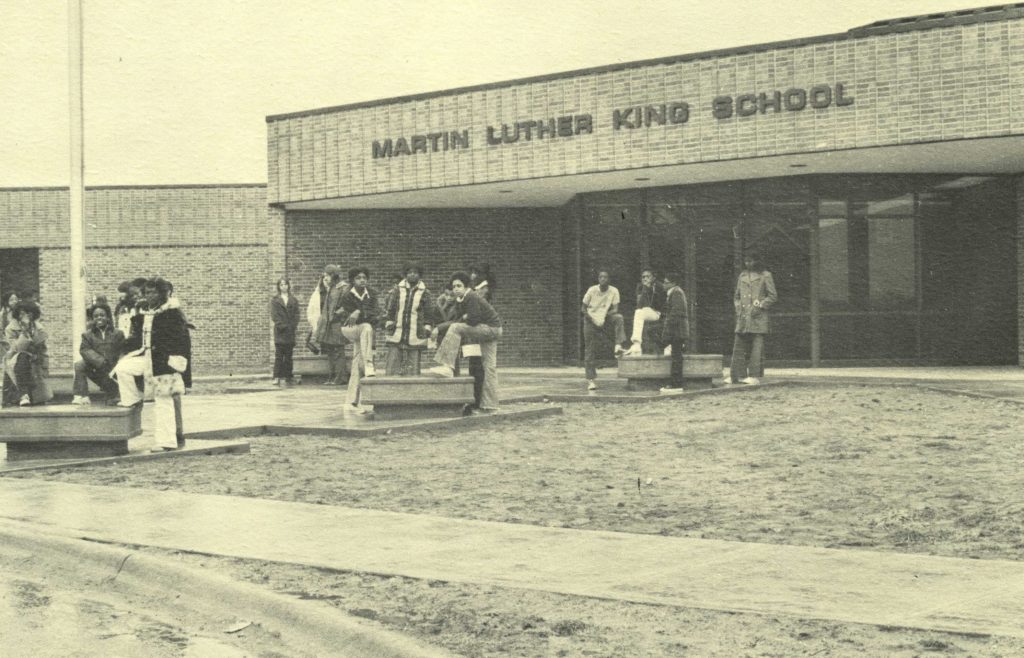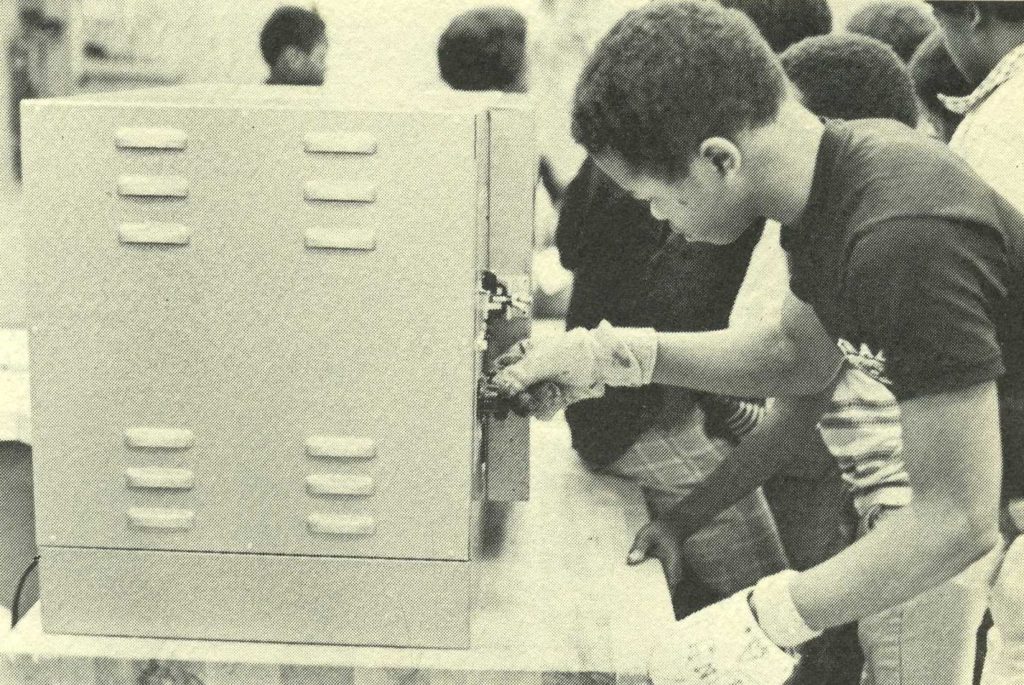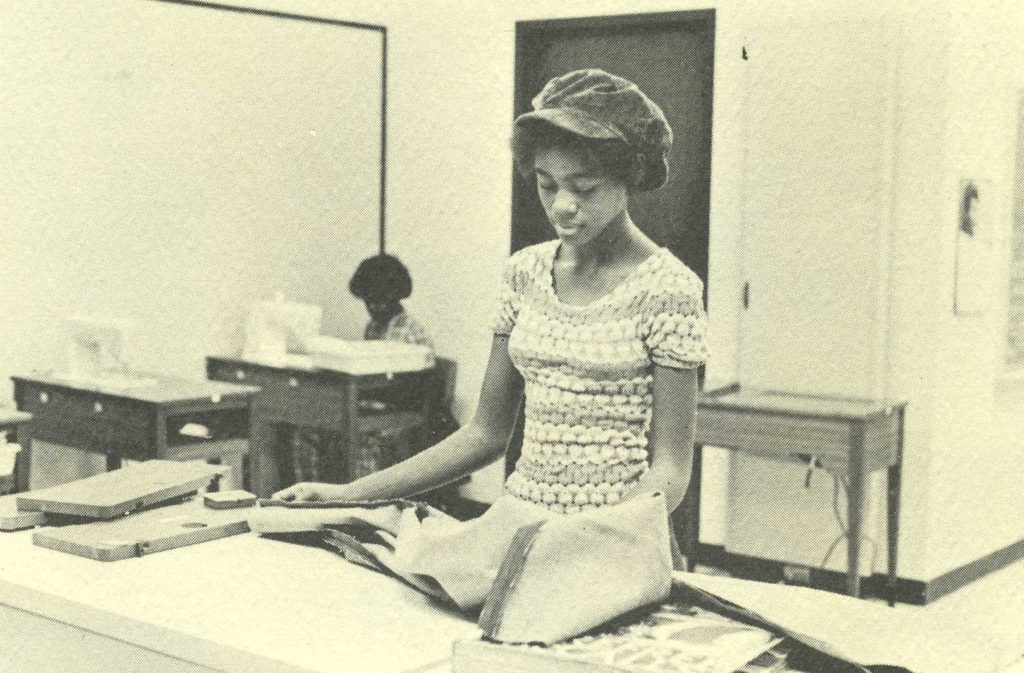By: Natalie Kammerer
Martin Luther King, Jr.’s legacy as a civil rights leader is reflected in the history of the school that was named for him. It was the first Omaha Public School named for an African American, and the first commemoration of Dr. King in Omaha. Its design first went before the Board of Education in 1969, the year following Dr. King’s assassination, and it was decided that the school should be named for him because he was a good role model for students of all races.[1] It seems particularly fitting that this school was named for Dr. King, because its opening in a predominantly African-American neighborhood provided the flashpoint which finally spurred the Omaha School District, as it was known then, to provide a desegregation plan for its schools. But that was only after the U.S. Justice Department sued the district for racial discrimination.

Martin Luther King Middle School opened at 3706 Maple Street in September of 1973[1], near the southwest corner of Adams Park. Even before discussing the legal issues surrounding the opening of MLKMS, there were several aspects of the school that made it notable for its time. It had the distinction of being the first middle school in OPS, and it was meant to ease overcrowding at both Franklin and Clifton Hill Elementary Schools, as it was located less than a mile from each. Its design embraced the concept of team teaching, and offered courses such as industrial arts, homemaking, art, and science not available in a typical elementary school.[2]


The staff made goals to support the original philosophy of MLKMS, which was “a plan to make the school fit the child, not the child fit the school.”[1] While these goals were groundbreakingly student-centered, addressing the whole child and his or her needs, as well as nurturing a civically and morally-minded student body, they could not address the de facto segregation that still defined public education in predominantly African-American neighborhoods at that time. By 1973, the Omaha School District had not yet addressed the segregation in its own district. Although the Supreme Court had ruled that
“separate is not equal” in the case of Brown v. the Board of Education in 1954,[1] it wasn’t until the passage of the Civil Rights Act in 1964 that the Justice Department was granted the power to enforce this ruling.[2]
Many parents whose students were in the MLKMS attendance area were upset that its location would perpetuate segregation. Overcrowding of neighborhood schools necessitated that the new school be located within the predominantly African-American neighborhood,[3] but the district made no effort to integrate King’s attendance zones. One zone actually pulled Black students from the integrated Monroe Junior High. Other zones kept white students from attending the school, sending them to predominantly white junior highs that were farther from their homes than King.[4] The Justice Department requested an injunction against the opening of MLKMS, citing that an integration plan needed to be in place and that discriminatory transfer policies needed to change before the school opened, as this would be in the best interest of all parties.[5] The request was denied, and the school opened that September with 800 students,[6] 82% of whom were Black.[7]

The Justice Department pushed forward with a racial discrimination lawsuit against the district. Eugene Leahy, who had just served as Omaha’s mayor, agreed with the lawsuit, urging citizens “to obey the law of the land” and to back efforts meant to provide equal educational opportunities for all Omaha students.[1] After the injunction failed, the Justice Department alleged that the district was not following its own neighborhood policy, instead using a “selective open school policy at the high school level…optional zones at the junior high level and a discriminatory transfer policy at all levels.”[2] The department also pointed out that while only 19% of students in the district were African-American, more than 60% of these students attended only 12 schools which had a 70-100% African-American enrollment, while 49 elementary schools, eight junior highs and four high schools were “either solely or predominantly” white.[3]
The Legal Aid Society joined as a third party in the lawsuit, representing 32 Black plaintiffs, both students and their parents, in a class action lawsuit effectively representing “all [B]lack children enrolled in the Omaha public schools and their parents.”[4] In clarifying their involvement, Legal Aid referenced third party representation in at least three other cities where desegregation lawsuits had taken place, explaining that on critical issues the Justice Department may “adopt a dramatically different stance from that favored by [B]lack students….”[5] Three attorneys from the Harvard Center for Law and Education who specialized in school desegregation also helped with the case.[6]
In June of 1975, the 8th Circuit Court of Appeals ruled that the Omaha public school system was intentionally segregated and directed the district to make a plan for both faculty and student integration.[7] African American civic leaders were pleased with the ruling and warned the Board of Education that appealing the decision would be a waste of time and money, saying their resources needed to go towards integrating the schools, not fighting the decision.[8] Despite pushback from the Board of Education, an integration plan was eventually adopted.
In 1976 when Omaha Public Schools enacted its desegregation plan, Martin Luther King Middle School evolved into one of two ninth grade centers, serving students from many parts of the city. Twelve years later in 1988, the school moved to the site of the old Horace Mann Junior High, at 3720 Florence Blvd., becoming King Science and Technology Magnet Center.[9] Its previous location on Maple became King Elementary.
The concept of the magnet program introduced in the 1980s was to provide unique benefits in the form of focused subject matter – like science and technology – taught by specialized teachers as a way to add interest for “voluntary integration.”[10] King was an early example of the success for the model – in 1999, 446 students entered a lottery to compete for only 15 available spots in the 5th grade class.[11] The trend continued, with rare amenities like a planetarium, multimedia rooms, and lab spaces for both science and technology classes attracting families from around the district.
Although Martin Luther King Middle School has had a variety of identities over the last 50 years, its legacy has always been to provide an excellent education to deserving students. As King Science and Technology Center today, it continues to serve a multi-racial student body from across the city.


[1] Parsons, Dana. “Support Is Divided On New Race Group.” Omaha World-Herald. 9 August 1973, p. 8.
[2] “Hearing May Be Preview of School Suit.” Omaha World-Herald. 11 August 1973, p. 9.
[3] Ibid.
[4] Parsons, Dana. “Legal Aid Asks Part In School Racial Suit.” Omaha World-Herald. 12 October 1973, p. 17.
[5] Ibid.
[6] Ibid.
[7] Parrott, Larry. “Integrate Appeal Decision Monday.” Omaha World-Herald. 13 June 1975, p. 7.
[8] “Decision Hailed by Black Leaders.” Omaha World-Herald. 13 June 1975, p. 7.
[9] History of King Science and Technology Center. Accessed January 9, 2023: https://www.ops.org/domain/1051.
[10] Willcoxon, Shelley. “Magnet School Attracts a Crowd.” Omaha World-Herald. 28 June 1988.
[11] Matczak, Melissa. “Two New Magnet Schools Will Have Open Seats in August Omaha School District Magnets.” Omaha World-Herald. 13 May, 1999.
[12] Separate But Equal. Legal Information Institute. Cornell Law School, 2022. Accessed 10 January 2023: https://www.law.cornell.edu/wex/separate_but_equal#:~:text=On%20May%2017%2C%201954%2C%20the,Clause%20of%20the%20Fourteenth%20Amendment.
[13] Brown v. Board of Education: The First Step in the Desegregation of America’s Schools. History.com. Accessed 10 January 2023: https://www.history.com/news/brown-v-board-of-education-the-first-step-in-the-desegregation-of-americas-schools#:~:text=Finally%2C%20in%201964%2C%20two%20provisions,withhold%20funding%20from%20segregated%20schools.
[14] History of King Science and Technology Center. Accessed January 9, 2023: https://www.ops.org/domain/1051.
[4] “Integrated King Goal ‘At Opening.’” Omaha World-Herald. 11 August 1973, p. 9.
[15] Ibid.
[16] History of King Science and Technology Center. Accessed January 9, 2023: https://www.ops.org/domain/1051.
[17] “Blacks Up in Fringe Areas.” Omaha World-Herald. 4 November 1973, p. 12-B.
[18] Ibid.
[19] Ibid.
[20] Ibid.
[21] History of King Science and Technology Center. Accessed January 9, 2023: https://www.ops.org/domain/1051.